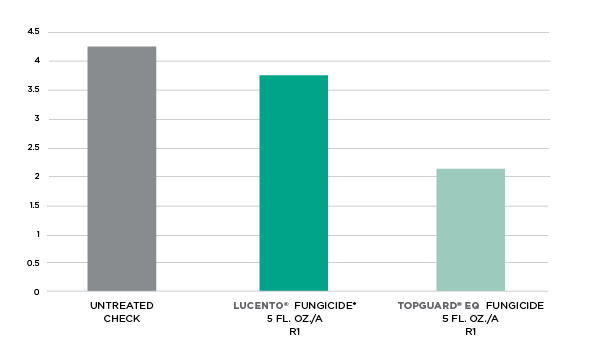Disease: Tar Spot
As a newer disease in the United States, tar spot was first identified in 2015 in Illinois and Indiana. Recent reports indicate it is now present in 13 states: IL, IN, IA, OH, MI, WI, MN, MO, GA, PA, KY, NE and FL. It is native to Latin America in cool, high altitudes.

Timing and Transmission
Tar spot is formed by producing a complex with Phyllachora maydis and Monographella maydis organisms. A third organism, Coniothyrium phyllachorae, has also been associated with the complex. M. maydis is thought to be the primary contributor to yield losses in its native Latin America. However, P. maydis is the only tar spot organism in corn that has been identified in the United States, and significant yield losses have been reported.
Identification and Dissemination
Tar spot is an obligate fungal pathogen that initiates lower in the canopy as a yellow-brown spot on the undersides of leaves and forms a raised black spot resembling tar. It is capable of occupying corn leaves, sheathes and husks.
Yield losses have been reported from 0-30% with an average of 8% in Central and South America. Tar spot can influence corn yields directly by reducing photosynthetic leaf area, in addition to causing plants to redistribute photo assimilates by scavenging stalks to fill grain, resulting in lodging. Researchers are also studying P. maydis complexes with other pathogens including fusarium ear rot, which encompasses mycotoxin properties. However, tar spot alone is not recognized as a mycotoxin.
Management
Management tactics for tar spot include selecting tolerant hybrids, if available, crop rotation, tillage and fungicide applications. Selecting premixes including multiple sites of action is critical. Optimal application timing is not well understood, but field observations indicate symptoms occurring during reproductive stages. Therefore, R1 applications will likely coincide with infection, but this will vary on a yearly basis. Research has demonstrated suppression with fungicide applications and the importance of a diversified management strategy.
- Adastrio™ fungicide (FRAC Groups 3, 7 & 11) can be applied foliarly and has three active ingredients to help protect corn from tar spot. This innovative fungicide combines a novel molecule in the SDHI class, fluindapyr with one of the most systemic triazoles on the market, flutriafol and azoxystrobin.
- Foliar fungicides like Lucento® fungicide (FRAC Groups 3 & 7) and Topguard® EQ fungicide* (FRAC Groups 3 & 11) can be applied at the V1-R1 growth stages to help protect against this yield-robbing disease.
Performance Data
TAR SPOT % SEVERITY
UNIVERSITY OF WISCONSIN, 2018

*Topguard EQ fungicide recommendation is permitted under FIFRA Section 2(ee) for use in corn (field, corn grown for seed, sweet corn and popcorn) for control of tar spot in the states of Arkansas, Connecticut, Delaware, Idaho, Illinois, Indiana, Iowa, Kansas, Kentucky, Maine, Maryland, Massachusetts, Michigan, Minnesota, Missouri, Montana, Nebraska, New Hampshire, New Jersey, North Dakota, Ohio, Oklahoma, Pennsylvania, Rhode Island, Utah, South Dakota, Tennessee, Vermont, Virgina, West Virginia, Wisconsin and Wyoming. The 2(ee) expiration date is 05/25/25.
Always read and follow all label directions, precautions and restrictions for use. Some products may not be registered for sale or use in all states. FMC, the FMC logo, Adastrio, Lucento and Topguard are trademarks of FMC Corporation or an affiliate. ©2023 FMC Corporation. All rights reserved. 22-FMC-3113 07/23



